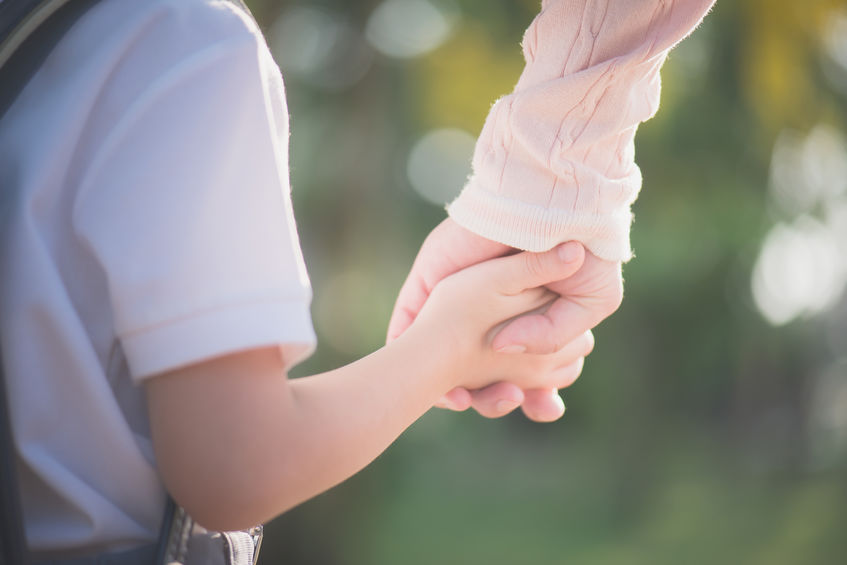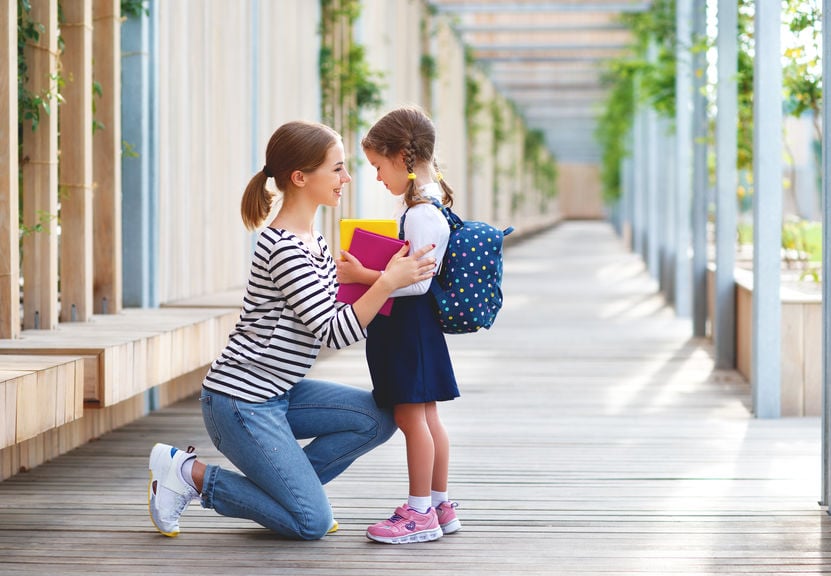
Does this scene feel familiar?
Going to school, especially for the first time, can be such an exciting experience. Engaging with others, exploring a new classroom, learning new things, and playing with friends are all important things to look forward to, but school days can also be riddled with stress and anxiety, especially after this tumultuous year. We know that levels of anxiety have risen during this time, even among our youngest learners. Our job as parents, caregivers, and educators is to support children in their transition back to school, and help them to socialize, explore, and feel ready to learn during this back-to-school season. So how can we collectively encourage children to persist in the face of anxiety? How can we as educators set the tone for the rest of the year, when first day and new school year anxiety is at an all-time high? Emotional regulation is key.
Creating routines and what we like to call “goodbye plans” can help children feel more in control whenever big feelings arise, particularly around the often emotional experience of separating from parents and caregivers to start the school day. In our ECSEL classroom, we have had more than our fair share of experiences with difficult drop-offs, separation anxiety, and sudden dysregulation among the children in our care. From our begin to ECSEL training, we have learned that before a child can begin to think about how to start the day, transition back to an activity, or even say goodbye, they need to be in control of their feelings. This can seem like a big ask in the heat of the moment, but when in doubt, we start with three important steps:
As we reflect on how important and effective emotional regulation plans can be, one child, in particular, comes to mind. We’d like to share her story with you all to illustrate how a little attention, regulation, and consistency can go a long way in supporting children in becoming the boss of their feelings:
Like many of the children at our school, Madeline had been enrolled in the begin to ECSEL program since infancy, but starting a new year in a new classroom as a preschooler is an experience that comes with its own set of big feelings. Being dropped off at the classroom each morning while being faced with having to say goodbye to mom was Madeline’s tipping point - her heightened emotions began to boil over. They boiled over until having these big feelings became somewhat of a routine each and every morning. This transition was becoming stressful and exhausting for both Madeline and her mom, so we got to work on finding the right goodbye plan to help Madeline feel in control of her big goodbye feelings and have a successful start to her day, everyday.
That is when our three steps came into play.
Step 1: Use tools and regulation strategies to help calm heightened emotions
In our ECSEL classroom, we keep a variety of tools and strategies in our toolkit to help each child calm down and regulate their big feelings. For some children, being able to check in on Our Emotions Board with a parent is just what they need to start their day. They can even show their families how their feelings have changed at pick up. Some children need space in a CalmDown Corner to calm down with pillows, a book, or a begin to Calm Down Bottle. Others may need to talk to a teacher about what they are feeling, and require options to make a choice that will start their day.
In Madeline’s case, the cause behind her feelings was her impending separation from mom, and not feeling ready to say goodbye. This is a common experience amongst young children, and our calm down kit in the CalmDown Corner is a great resource to help ease the goodbye transition. Calm Down Kits personalize the comfort each child needs and can include any items best suited for the children in your classroom, including begin to Calm Down Bottles, family photos, books about feelings, or communal lovies for younger children. For Madeline, family photos in our calm down kit was the perfect place to start. We would ask if she would like to take mom to the CalmDown Corner to find her family photo - a task both simple enough to not cause big feelings to become any bigger, and personal enough to give Madeline the agency to begin to calm down. Madeline loved to go through each of the photos, find the pictures of her family, and point to each family member while telling us their names. Her feelings of sadness were understandably still there, but having the family pictures to hold made it just a little bit easier to manage them.
Step 2: Create a plan to establish safety and structure for the child
Once a child begins to feel more calm and in control of their feelings, it is easier to move forward and start thinking of a goodbye plan that works best for them. For Madeline, we needed to create a goodbye plan that would work for her and her mom. In getting to know Madeline, we learned that she loved to be creative, especially in expressing herself through drawing - it gave her confidence, which we frequently validated in the classroom. So, we asked mom if she could stay to draw a picture with Madeline as her goodbye plan each morning and yes, the plan was in motion. Madeline’s feelings visibly shifted - her eyes lit up and she would excitedly take her mom’s hand and bring her to the art table, like a whole different Madeline! She and her mom would work together drawing their picture-of-the-day: sometimes a castle that Madeline could continue working on after mom left, and sometimes a complete picture that she could keep in her cubby and look at whenever a pang of sadness would come back during the day.
Step 3: Be consistent, and follow through with the plan with family members
After the goodbye plan is established, the last and arguably the most important step is to follow through and make sure this plan becomes a consistent part of the child’s routine. Consistency and repetition are not only important for learning, but for creating a sense of security and predictability around emotional moments. Over time, the child may initiate this routine independently, or may not even need to rely on their established plan as much as they used to because they have learned how to manage their once dysregulated emotions. This is exactly what happened for Madeline.
As Madeline’s teachers, we made sure one of us was there in the morning to welcome her and mom into the classroom, and guide them to start their day by looking through family photos. Sometimes, this jumpstart to the routine was all Madeline needed to head over to the art center with mom all by herself, and other times she needed some gentle guidance and support from us to remind her about the next step in her goodbye plan. We made sure to establish clear boundaries around the goodbye routine, meaning once the picture with mom was finished it was time to say goodbye. Some days, this was really hard, and we would make sure to help Madeline with any leftover big feelings by asking about the picture she made with mom, helping her find her family photos again, or just giving her some extra space. Other days, Madeline was the one to nudge mom out the door and excitedly show her picture to her friends. After a while, this routine became second nature for Madeline, so even if she still had sad feelings when mom left, she was able to come up to one of us and let us know. As the year progressed, Madeline was slowly but surely able to initiate her goodbye plan independently, without help from a teacher. This soon evolved into a quick goodbye at the door as she made a play choice with friends and started her day with ease. This was the reassurance that we (and her mom) needed, letting us know that Madeline had a new set of tools in her emotional regulation toolkit.

It is important to remember that just like all of us, young children are going to experience big feelings and heightened emotions even with the best of routines in place. After all, they’re only human, and just starting to learn about those big feelings and what to do with them. In giving them the tools they need to begin to regulate and manage these big feelings, we are providing the security and structure for them to safely experience their emotions, and hopefully ease the stress and anxiety that is only natural when returning to school, whether at the start of the school year or each and every day.
Use begin to ECSEL Tools to Regulate
Techniques for Establishing Safe Routines & Structure
These Posts on Emotional Intelligence
Housman Institute, LLC
831 Beacon Street, Suite 407
Newton, MA 02459
info@housmaninstitute.org
(508)379-3012
Explore
Our Products
Legal
Connect
Contact
Join our Mailing List!
Subscribe to receive our newsletter, latest blogs, and ECSEL resources.
We respect and value your privacy.
No Comments Yet
Let us know what you think